Services on Demand
Article
Indicators
Related links
-
 Cited by Google
Cited by Google -
 Similars in Google
Similars in Google
Share
Journal of the Southern African Institute of Mining and Metallurgy
On-line version ISSN 2411-9717
Print version ISSN 2225-6253
J. S. Afr. Inst. Min. Metall. vol.123 n.5 Johannesburg May. 2023
http://dx.doi.org/10.17159/2411-9717/2482/2023
PILLAR DESIGN EDITION
Bord-and-pillar design for the UG2 Reef containing weak alteration layers
P.M. CoutoI; D.F. MalanII
ICartledge Mining and Geotechnics, Queensland, Australia
IIDepartment of Mining Engineering, University of Pretoria, South Africa
SYNOPSIS
We propose a layout design for the UG2 Reef where weak geological alteration layers are present. The collapse of the Everest platinum mine in South Africa indicated that these layers substantially weaken the pillars. The popular Hedley and Grant pillar strength formula cannot be used where these alteration layers are present. Underground investigations at Everest mine and numerical modelling of the layout were conducted using the TEXAN code and a limit equilibrium model. Simulations of a collapsed area and an intact area allowed for a preliminary calibration of the model. This was subsequently used to explore modified layouts for these ground conditions. An alternative is to compartmentalize the blocks of ore using barrier pillars. The numerical modelling predicted that the barrier pillars appear to remain stable even in the case of large-scale collapses, provided their width exceeds 25 m. Main access routes into the mine can be protected by a double row of pillars at least 15 m wide to provide a safe travelling way. As a cautionary note, these conclusions are based on the model calibration and this needs to be refined in future. Calibration of the limit equilibrium model remains a challenge owing to the large number of parameters involved.
Keywords: UG2 Reef, bord and pillar. Layout design, limit equilibrium model, TEXAN code.
Introduction
The strength of hard rock pillars has been studied extensively and a large number of publications are available on this topic (e.g. Martin and Maybee, 2000; Malan and Napier, 2011). Pillar design in the Southern African hard rock industry is mostly based on the Hedley and Grant (1972) pillar strength formula. In comparison, extensive research on pillar strength in the coal industry, following the Coalbrook colliery disaster (van der Merwe, 2006), has resulted in a much-improved understanding of coal pillar strength. Research on stable layouts and pillar strength for the manganese, chrome, and platinum mines in South Africa has unfortunately not received the same attention. The Hedley and Grant power-law strength formula, as given in Equation [1], was widely adopted as no suitable alternative was available. The K-value is typically modified to suit local geotechnical conditions.

where
Ps = pillar strength
K = in-situ strength of the rock mass in the pillar (typically assumed to be a downrated value of the UCS)
w = pillar width
h = pillar height
α = 0.5
β = 0.75
Extensive work was done to determine the most appropriate value of K for different orebodies and commodities (e.g. see Malan and Napier, 2011). In contrast, almost no research has been done for areas where a geological alteration or other weak layers are present in the reef horizon or close to the reef (Couto, 2020). This has led to large mine-scale collapses of pillars. Hartzenberg, du Plessis, and Malan (2020) define the alteration layer as follows: 'The hangingwall contact of the UG2 chromitite reef at these sites consists of pyroxenite. The pyroxenite layers have been exposed to hydrothermal fluid flow, serpentinization and layer-parallel shearing. The resulting clay-like material (weak partings) is defined as the alteration zone'. Alteration is a common term used in geology to describe the transformation of rocks and minerals due to various processes such as weathering, metamorphism, and hydrothermal activity. The Hartzenberg definition above is, however, adopted for this study as it refers to weak layers in the pillars which may affect the pillar strength. Some authors also simply refer to this alteration layer as a weak 'clay layer' in the pillars.
Spencer (1999) reported on the pillar failures at the Wonderkop chrome mine in the Bushveld Complex. The mine exploited the LG6/LG6a chromitite seams. Thick clay layers (up to 300 mm in some places) traversed the pillars in some areas. The original pillar design at the mine was done using the Hedley and Grant pillar strength formula. The pillar sizes were 12 m χ 6 m and the mining height was 2 m. The K-value for the Hedley and Grant formula was assumed to be one-third of the third of the laboratory strength of the pillar material (27 MPa). The clay layers resulted in unexpected failure of the pillars and the mine was closed in May 1998, less than two years after stoping operations commenced. Another (unpublished) case study of a mine collapse in the Great Dyke in Zimbabwe, where a weak parting with infilling was also present in the pillars, is known to the authors. Malan and Napier (2011) indicated that geological alteration may be present in pillars in both the western and eastern Bushveld Complex. These have a detrimental effect on pillar strength and on overall mine stability. Any weak layers in the pillars need to be carefully taken into account during mine design.
It is well known that the strength of rock samples tested in the laboratory is affected by the 'boundary conditions' imposed at the contact between the testing machine platens and the rock specimen. A low friction angle typically causes axial splitting of the specimens and a significant reduction in strength is noted compared to the typical shear failure at higher friction angles (see e.g. Peng, 1971; Jaeger and Cook, 1979; Wagner, 1980). Peng (1971) observed that significant tension can be induced if soft extruding contacts are used in compression testing. He also noted that the strength of granite samples tested in the laboratory can drop from as high as 207 MPa to 96 Mpa, depending on the types of inserts used between the specimens and the loading platens. For actual pillars where there is a low friction angle contact between the pillar and hangingwall, it seems that the strength behaviour may be analogous to that recorded in the laboratory. A significant decrease in pillar strength is therefore expected. It is, however, extremely difficult to determine the actual reduced pillar strength for practical design purposes. If the design is too conservative it affects the economic viability of the mine, whereas a less conservative design may lead to a mine-wide collapse.
The collapse at the Everest platinum mine, where an alteration zone was present, was studied in detail by Couto and Malan (2023). The current paper extends this work to explore a possible practical mine layout that may be used when these poor ground conditions are encountered.
Observations at Everest platinum mine
The authors conducted two underground visits to Everest platinum mine to investigate the large-scale pillar collapse. The objective was to gain an improved understanding of the failure mechanism, obtain photographs of the failed pillars, and to identify areas suitable for calibration of the numerical models. Figure 1 illustrates a plan view of the mine and the different pillar failure zones.

The initial pillar design, in the area where the collapse occurred, incorporated pillars with dimensions ranging from 5 m χ 5 m to 6 m χ 6 m depending on depth, with an average mining height of 2.1 m. Many of the pillars that could be measured during the underground visits where smaller than these sizes. The mine plan, based on survey offsets done prior to 2008, also indicated that the pillar cutting was done poorly. Many pillars were cut smaller than the design specifications. This is considered an important factor contributing to the failure of the pillars. The amount of pillar scaling could be estimated during the underground visits as the original boundaries of the pillars were still clearly visible on the hangingwall because of the shotcrete or whitewash colour imprints.
The stoping width was measured at a number of points along both routes during the visits. Historical records indicate that the mining height varied between 2 m and 2.2 m. Measurements of the stoping height in the zone where no pillar failure occurred revealed an average value of 2.1 m. Closer to the declines, the stoping width gradually decreased, with a final stoping width of 1.3 m in the decline area. It therefore seems that a total amount of closure of at least 700 mm occurred in some areas. Tensile fracturing was observed in the hangingwall close to the declines. These discontinuities had a vertical displacement of approximately 2 cm and an opening displacement of 1 cm in some areas.
The weathering of the alteration layer was evidenty because of exposure to atmospheric conditions. The presence of water and the high humidity had transformed the geological alteration layer into a weak 'clay layer' that seemed to have no cohesive properties and a very low friction angle. This needs to be tested in the laboratory in future to better quantify the properties. The alteration zone was squeezed out between the reef-hangingwall contact in many areas.
Figures 2-9 illustrate photographs of the pillars taken during the underground visits. The presence of the alteration zone in the pillars is evident in some of these photographs and a close-up view is given in Figure 7.








Numerical modelling calibration
As described in Couto and Malan (2023), TEXAN modelling with the limit equilibrium model was used to simulate the pillar failure at Everest platinum mine. The model is described in detail in Napier and Malan (2007, 2021). The limit equilibrium model is an elegant model to use for pillars where there is a weak layer present at the hangingwall/pillar contact as the model contains a frictional interface at this position. The drawback of the model, however, is that it is symmetrical, with partings at both the hangingwall and footwall contacts, and the friction angle is similar for these partings. The limit equilibrium model contains a large number of parameters and various simulations were conducted to obtain a best calibration of the model. The details of these simulations are given in Couto and Malan (2023) and will not be repeated here. Table I illustrate the calibrated parameters. Two areas were simulated, referred to as the collapsed area and the intact area. The collapsed area was in the level 5 area in Figure 1 and the intact area was in level 1. As explained below, the only difference in calibrated values for the two areas was the interface friction angle. The reason for the difference is described in Couto and Malan (2023). It was assumed that the presence of water was an important difference between the intact and the collapsed areas. The alteration layer was dry in the intact area and moist in the collapsed area. The friction angle of the pillar contact was, therefore, probably lower in the collapsed area than in the intact area. No laboratory test results of these friction angles are available and this material needs to be tested in future. It should be noted that the limit equilibrium model does not include a cohesion component. This implies a zero cohesion, which is considered to be a good approximation of the characteristics of the alteration layer.

The parameters given in Table I (with the lower friction angle) were used as a first approximation of the pillar strength to design a pillar layout for areas with a geological alteration layer similar to the ground conditions at Everest platinum mine. As a cautionary note, this is only a preliminary model calibration and it needs to be refined in future. Calibration of the limit equilibrium model remains a challenge owing to the large number of parameters involved. The simulated conditions of the pillars for the two areas mentioned above using these parameters are shown in Figure 10. The simulation agrees with the underground observations for these two areas. The pillars on the edges of the collapsed area are still intact, but this is due to the fact that the modelled area is relatively small and these pillars are next to the artificial abutments in the model. It was encouraging that the same parameters, apart from the value of the friction angle of the interfaces, could be used to simulate the two areas. The geological alteration is clearly detrimental to the stability of UG2 pillars, especially when it is exposed to water or high humidity.
Careful simulation of the two areas and the actual pillar shapes allowed for the back-calculation of the K-value for the Hedley and Grant pillar formula. For this back-calculation, the pillars were simulated as rigid pillars and the average pillar stress (APS) values were calculated for each pillar. For the collapsed area, the pillars failed at these APS values and this was therefore assumed to be the maximum strength of the pillars. The calculated average K-value for the collapsed area was 19 MPa. The value for some of these failed pillars was below 10 MPa and K = 10 MPa may therefore be a good approximation to use for the Hedley and Grant formula for these types of pillars. This will result in extremely conservative layouts and it illustrates the effect of these alteration layers on pillar strength.
Mine design considerations
Large-scale collapses and the traditional empirical pillar design methods indicate that alternative mine layouts are required where geological alteration layers are present. The mining layouts considered below are for a bord-and-pillar mining method in a tabular, shallow-dipping orebody, such as those typically encountered in the Bushveld Complex in South Africa. It is therefore an important problem to solve to ensure that mechanized mining can be implemented in the future, even for these orebodies that contain weak geological alteration layers. This study highlighted three critical factors that influenced the overall stability of the pillars when encountering geological alteration. These factors need to be considered during any design, regardless of the mining layout.
> The ingress and management of groundwater. The presence of water should be limited as far as practically possible.
> The ongoing monitoring of pillar sizes is critical to ensure that the pillars are cut as per the design specification. The monitoring should also be extended to existing pillars to record any early signs of pillar scaling.
> The use of regional or barrier pillars is critical to compartmentalize the mine. This will prevent mine-wide collapses. To ensure economically viable mining operations, a minimum extraction ratio needs to be attained. This will require small in-panel pillar sizes, together with regional pillars to ensure regional stability.
A number of alternative mining layouts were considered. Owing to the requirement of a mechanized mining operation and the characteristics of the orebody (narrow seam, tabular, flat-dipping), the only practical option was a compartmentalized bord-and-pillar mining method. The mining layout considered is based on rock engineering and practical mining knowledge with the objective of achieving the highest possible extraction ratio.
The proposed mining layout for these geotechnical conditions is shown in Figure 11. Note that the diagram shows only part of the layout to illustrate the inclusion of barrier pillars. Each 'compartment' will contain 144 pillars of size 7 m χ 7 m and will be surrounded by large barrier pillars with holings at specified distances. The modelling was based on a depth of 200 m. The limit equilibrium model parameters obtained from the calibration exercise described above were used for the simulations. This is deemed a worst-case scenario in terms of pillar strength.
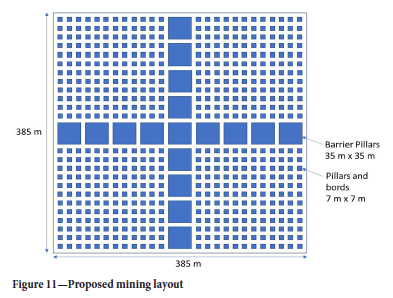
The proposed mining layout allows maximum extraction with protection of infrastructure, entrances, and exits. This layout can be problematic with regard to the mining sequencing if not followed strictly as per the mine scheduling. Conventional mining methods require a specialized crew allocation based on the either development, ledging, or stoping. Bord-and-pillar mining does not require the specialized crew for on-reef development. The proposed mining layout will, however, require the allocation of specialized crews for both development and stoping to ensure the availability of mining blocks as scheduled by the mine planner. The large barrier pillars will require optimized ventilation layouts to ensure airflow and adequate cooling.
A rock engineering benefit of a compartmentalized layout and the pre-development of mining blocks will be the early identification of a change in geological conditions. This will allow for better planning in terms of larger geological structures such as potholes and aspects such as optimum mining directions relative to joint orientations. This will allow for safer mining conditions and more mining flexibility.
Compartmentalization will allow for each mining block to achieve an extraction ratio (which includes the barrier pillars) that typically varies from 69% to 74% while maintaining the overall stability of the mining operation. Table II shows the difference in extraction ratio for different size barrier pillars. Layout 1 is the traditional Everest platinum mine layout, which is used as a baseline with which to compare the proposed new extraction ratios. Layout 2 shows the decrease in extraction ratio if pillars are designed with more conservative parameters using a traditional bord-and-pillar layout. Layout 3 is the proposed new layout for different barrier pillar sizes.

Figures 12 to 16 illustrate the simulated pillar failure for different barrier pillar widths. The objective of this modelling was to determine if the barrier pillars will survive the complete collapse of all the in-panel pillars on a scale similar to the Everest platinum mine collapse. Note the extensive failure of the in-panel pillars in all cases. Some spalling is noted on the 15 m and 20 m wide barrier pillars after the collapse of the in-panel pillars. For the current model calibration, it is therefore recommended to use at least 25 m wide pillars. To ensure safe travelling throughout the mine in case of large collapses, the split barrier option presented in Figure 17 may be a good solution. The simulated amount of scaling on the pillars is only minor and not more extensive than that experienced by the solid 35 m wide pillars. This option gives an extraction ratio of 69%. Although less than the typical 75%, it should be considered that it is very difficult to maintain excavation stability for these ground conditions and the slightly lower extraction ratio will make safe mining possible.
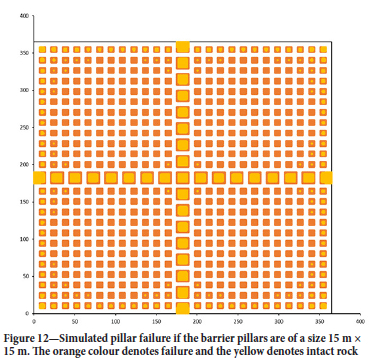
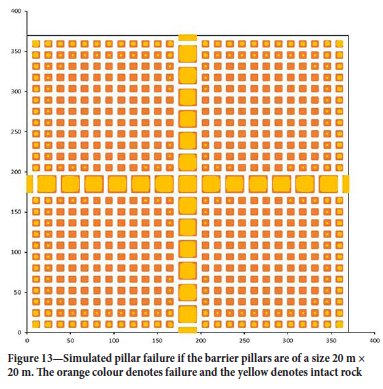
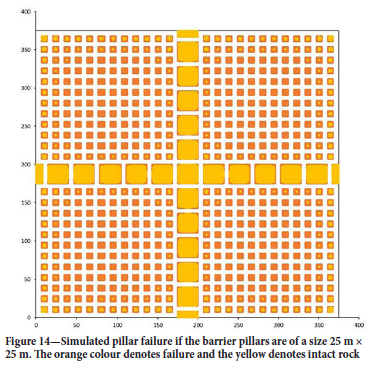
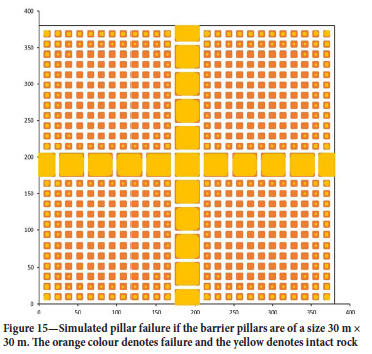
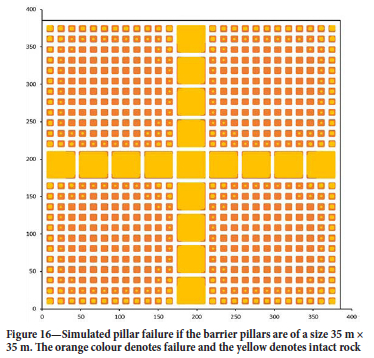
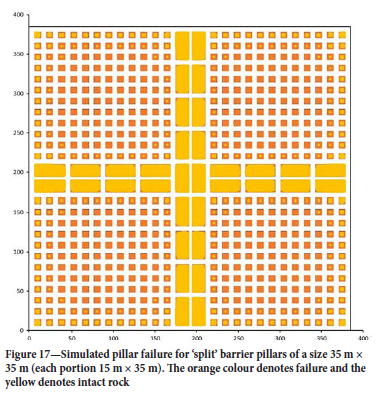
Conclusions
We investigated the effect of geological alteration layers on hard rock pillar strength. These alteration layers are found in the Bushveld Complex in South Africa where the pyroxenite has been exposed to hydrothermal fluid flow, serpentinization, and layer-parallel shearing. The resulting clay-like material and the weak partings substantially reduce pillar strength. Almost no information is currently available in the literature on appropriate design methodologies if weak layers are present in the pillars. The classical empirical pillar strength formulae are not applicable and their use for these pillars has already resulted in a number of mine-wide collapses. We propose an alternative numerical modelling approach to determine the stability of the bord-and-pillar layouts. The pillar shapes are mostly irregular in the hard rock mines and the displacement discontinuity boundary element method is the preferred analysis technique for mine-wide simulations. A limit equilibrium model is used to simulate the edge failure zone. A calibration of this model can then be used to design alternative layouts and appropriate barrier pillar sizes and spacings.
The collapse of the Everest platinum mine is used as a case study to test the application of the proposed methodology. Two areas were simulated, namely part of the collapsed area and a second area with larger pillars that is still stable. This allowed for a first-order calibration of the limit equilibrium model. The effect of friction angle on the weak partings was illustrated by these models. The calibrated values for the two areas were identical, except for a 10° friction angle for the collapsed area and 25° friction angle for the stable area. This difference seemed reasonable owing to the presence of water in the collapsed area, which resulted in weathering of the alteration layer and a decrease in the friction angle.
Barrier pillars will be necessary to compartmentalize the mine in areas where the alteration zones are present. The numerical modelling indicated that for the preliminary calibration of the model parameters, the barrier pillars will remain stable even in the case of large scale collapses, provided their width exceeds 25 m. Main access routes to the mining areas should ideally be protected by a double row of pillars at least 15 m wide, to provide for a safe travelling way. As a cautionary note, these pillar widths are based on the preliminary model calibration and this needs to be refined in future. The limit equilibrium model needs to be calibrated for site-specific conditions before stable pillar sizes can be determined.
Although encouraging results were obtained, calibration of the limit equilibrium model, and any other alternative inelastic model and modelling approach that will be used remains a challenge. Laboratory testing is required to determine the rock strengths as well as the friction angles of the wet and dry alteration zone material.
Acknowledgements
This work formed part of the MSc study of Paul Michael Couto at the University of Pretoria.
References
Couto, P.M. 2022. The effect of geological alterations on pillar strength. MSc. (Applied Science: Mining) dissertation, University of Pretoria. [ Links ]
Couto, P.M. and Malan, D.F. 2023. A limit equilibrium model to simulate the large-scale pillar collapse at th Everest Platinum Mine. Rock Mechanics and Rock Engineering, vol. 56. pp. 183-197. [ Links ]
Hartzenburg, A.G, du Plessis, M, and Malan, D.F. 2020. The effect of alteration layers on UG2 pillar behaviour in the Bushveld Complex. Rock Mechanics for Natural Resources and Infrastructure Development. Fontoura, R. and Mendoza, P. (eds). International Society for Rock Mechanics and Rock Engineering, Lisbon. pp. 2309-2331 [ Links ]
Hedley, D.G.F. and Grant F. 1972. Stope pillar design for the Elliot Lake uranium mines. Journal of the Canadian Institute of Mining and Metallurgy, vol. 65. pp. 37-44. [ Links ]
Jaeger I.e. and Cook, N.G.W. 1979. Fundamentals of Rock Mechanics, 3rd edn. Chapman and Hall, London. 576 pp. [ Links ]
Lombard, J. 2008. Large collapse of hangingwall over the declines from Strike 0 to Strike 5 - Everest Platinum mine. Internal mine report RED 103/08, 12 December 2008. [ Links ]
Malan, D.F. and Napier, J.A.L. 2011. The design of stable pillars in the Bushveld Complex mines: A problem solved? Journal of the Southern African Institute of Mining and Metallurgy, vol. 111. pp. 821-836. [ Links ]
Martin, CD. and Maybee, W.G. 2000. The strength of hard rock pillars. International Journal of Rock Mechanics and Mining Sciences, vol. 37. pp. 1239-1246. [ Links ]
Napier, J.A.L and Malan, D.F. 2007. The computational analysis of shallow depth tabular mining problems. Journal of the Southern African Institute of Mining and Metallurgy, vol. 107. pp. 725-742. [ Links ]
Napier, J.A.L. and Malan D.F. 2021. A limit equilibrium model of tabular mine pillar failure. Rock Mechanics and Rock Engineering, vol. 54. pp. 71-89. [ Links ]
Peng, S.D. 1971. Stresses within elastic circular cylinders loaded uniaxially and triaxially. International Journal of Rock Mechanics and Mining Sciences, vol. 8. pp. 399-432. [ Links ]
Spencer, D. 1999. A case study of a pillar system failure at shallow depth in a chrome mine. Proceedings of SARES99,2nd Southern African Rock Engineering Symposium, Johannesburg, South Africa. Hagan, T.O. (ed.). South African National Institute of Rock Engineering. pp. 53-59. [ Links ]
Van der Merwe, N. 2006. Beyond Coalbrook: What did we really learn? Journal of the Southern African Institute of Mining and Metallurgy, vol. 106. pp. 857-868. [ Links ]
Wagner, H. 1980. Pillar design in coal mines. Journal of the South African Institute of Mining and Metallurgy, vol. 80. pp. 37-45 [ Links ]
 Correspondence:
Correspondence:
D.F. Malan
Email: franscois.malan@up.ac.za
Received: 26 Nov. 2022
Revised: 13 Feb. 2023
Accepted: 30 May 2023
Published: May 2023














